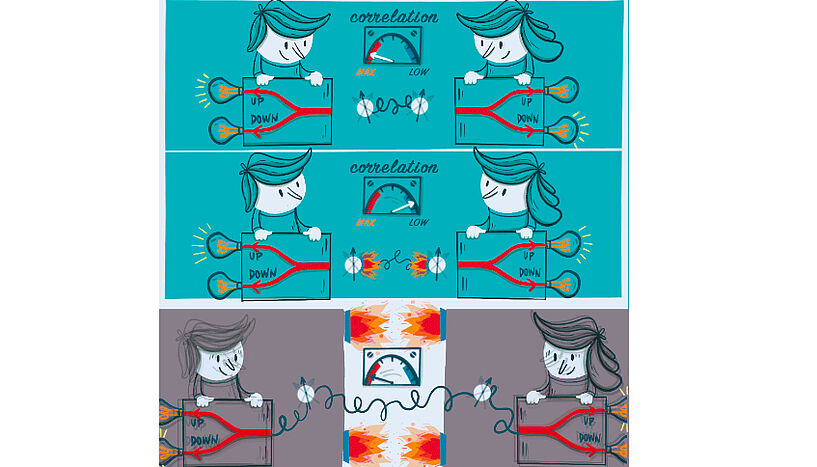Quantum-nonlocality at all speeds
16. Juni 2021
The new result proves that it is possible to design a Bell experiment for particles moving in a quantum superposition at very high speeds. (© ALOOP; ÖAW)
The phenomenon of quantum nonlocality defies our everyday intuition. It shows the strong correlations between several quantum particles some of which change their state instantaneously when the others are measured, regardless of the distance between them. While this phenomenon has been confirmed for slow moving particles, it has been debated whether nonlocality is preserved when particles move very fast at velocities close to the speed of light, and even more so when those velocities are quantum mechanically indefinite. Now, researchers from the University of Vienna, the Austrian Academy of Sciences and the Perimeter Institute report in the latest issue of Physical Review Letters that nonlocality is a universal property of the world, regardless of how and at what speed quantum particles move.
It is easy to illustrate how correlations can arise in everyday life. Imagine that each day of the month you send two of your friends, Alice and Bob, a toy engine of a set of two for their collection. You can choose each of the engines to be either red or blue or either electric or steam. Your friends are separated by a large distance and do not know about your choice. Once their parcels arrive, they can check the colour of their engine with a device that can distinguish between red and blue or check whether the engine is electric or steam using another device. They compare the measurements made over time to look for particular correlations. In our everyday world, such correlations obey two principles – "realism" and "locality". "Realism" means that Alice and Bob reveal only what colour or the mechanism of the engine you had chosen in the past, and "locality" means that Alice's measurement cannot change the colour or the mechanism of Bob's engine (or vice versa). Bell's theorem, published in 1964 and considered by some to be one of the most profound discoveries in the foundations of physics, showed that correlations in the quantum world are incompatible with the two principles – a phenomenon known as quantum non-locality.
Quantum nonlocality has been confirmed in numerous experiments, the so-called Bell tests, on atoms, ions and electrons. It not only has deep philosophical implications, but also underpins many of the applications such as quantum computation and quantum satellite communications. However, in all of these experiments, the particles were either at rest or moving at low velocities (scientists call this regime "non-relativistic"). One of the unsolved problems in this field, which still puzzles physicists, is whether nonlocality is preserved when particles are moving extremely fast, close to the speed of light (i.e., in the relativistic regime), or when they are not even moving at a well-defined speed.
For two quantum particles in a Bell's test which move at high speeds researchers predict that the correlations between the particles are, in principle, reduced. However, if Alice and Bob adapt their measurements in a way that depends on the speed of the particles the correlations between the results of their measurements are still nonlocal. Now imagine that not only are the particles moving very fast, but their velocity is also indefinite: each particle moves in a so-called superposition of different velocities simultaneously, just as the infamous Schrödinger's cat is simultaneously dead and alive. In such a case, is their description of the world still non-local?
Researchers, led by Časlav Brukner at the University of Vienna and the Austrian Academy of Sciences, have shown that Alice and Bob can indeed design an experiment which would prove that the world is nonlocal. For this they used one of the most fundamental principles of physics namely that physical phenomena do not depend on the frame of reference from which we observe them. For example, according to this principle, any observer, whether moving or not, will see that an apple falling from a tree will touch the ground. The researchers went a step further and extended this principle to reference frames "attached" to quantum particles. These are called "quantum reference frames." The key insight is that if Alice and Bob could move with the quantum reference frames along with their respective particles, they could perform the usual Bell test, since for them the particles would be at rest. In this way, they can prove quantum nonlocality for any quantum particle, regardless of whether the velocity is indefinite or close to that of light.
Flaminia Giacomini, one of the study's authors, says, "Our result proves that it is possible to design a Bell experiment for particles moving in a quantum superposition at very high speeds." The co-author, Lucas Streiter, concludes, "We have shown that nonlocality is a universal property of our world." Their discovery is expected to open applications in quantum technologies, such as quantum satellite communications and quantum computation, using relativistic particles.
Publication in Physical Review Letters:
L. F. Streiter, F. Giacomini, Č. Brukner, "Relativistic Bell Test within Quantum Reference Frames", Phys. Rev. Lett., 2021 DOI: 10.1103/PhysRevLett.126.230403
Wissenschaftlicher Kontakt
Univ.-Prof. Mag. Dr. Caslav Brukner
Institut für Quantenoptik und Quanteninformation WienUniversität Wien
1090 - Wien, Boltzmanngasse 5
+43-1-4277-725 82
caslav.brukner@univie.ac.at
Rückfragehinweis
Pia Gärtner, MA
Pressebüro der Universität WienUniversität Wien
1010 - Wien, Universitätsring 1
+43-1-4277-17541
pia.gaertner@univie.ac.at
Downloads:
Brukner_01.png
Dateigröße: 151,38 KB
